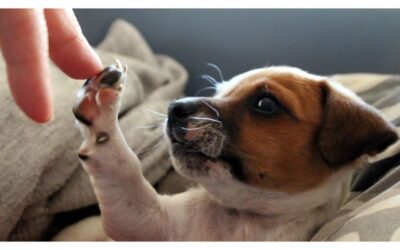Dogs eat crayons primarily due to their curious nature and the attractive scents or flavors that crayons might carry. It’s a behavior that often stems from boredom or the need to chew.
Curiosity and playfulness are inherent in dogs, leading them to taste and chew on various objects – crayons being no exception. Pet owners often observe their furry friends exploring the world with their mouths, which can include sampling non-food items.
This peculiar habit is part of a dog’s investigative process, and sometimes the bright colors of crayons can capture their attention. A dog’s need to gnaw comes from an instinctual place, aiding in keeping their jaws strong and their teeth clean. Additionally, crayons might have a texture or scent that intrigues a dog, making them an accidental snack. Such behavior requires monitoring by pet owners to prevent any potential health risks, as crayons can sometimes contain materials that are not safe for consumption. Proper stimulation and access to suitable chew toys can deter dogs from eating inappropriate items like crayons.
Canine Curiosity And Crayon Consumption
Dogs are naturally drawn to bright hues, which may explain their interest in colorful crayons. Crayons’ vivid colors stimulate dogs, catching their attention and sparking their curiosity. The texture of crayons can also be enticing to canines. They enjoy chewing on objects that have a smooth, waxy texture. Scent plays a significant role too, as crayons often possess a faint, appealing smell. This can make crayons seem like a tempting snack to an inquisitive pup.
Distinguishing Play From Pica
Dogs often explore the world with their mouths. This curiosity can lead to eating non-food items, such as crayons. Not all chewing or mouthing is harmful. It is normal for dogs to play with objects. But when a dog eats things like crayons often, it may be a sign of pica. Pica is a condition where animals eat items that are not food.
Signs that a pet may have pica include repeatedly eating non-edible objects and doing so with intense focus. It’s important for pet owners to differentiate between a dog simply playing with a crayon and one that is compulsively eating them. If a dog eats strange things often, it should see a vet. Ignoring these signs can lead to health problems for the dog.
The Risks Of Non-food Items
Dogs may eat crayons for various reasons, including curiosity or the scent and taste. Eating crayons can lead to health risks such as choking, blockages in the intestines, or possible toxicity. Non-food items do not digest well and can harm your pet’s health.
Immediate veterinary attention is necessary if your dog shows any signs of distress after eating crayons. Symptoms like vomiting, diarrhea, or lethargy are red flags. Consulting a vet ensures your dog gets the care they need quickly. Keep all crayons out of reach to prevent your dogs from eating them.
Training Tips To Prevent Unwanted Chewing
Dogs love to chew on various objects, and sometimes they choose crayons. Training your dog to avoid such habits is essential. One effective method is using positive reinforcement; reward your pet for good behavior instead of chewing on crayons. Rewards like praise, petting, and treats can encourage your furry friend to make better choices.
Offer your dog safe and suitable alternatives for chewing, like recommended chew toys. These are designed to be safe for dogs and can help keep them engaged. A variety of textures and shapes can keep the play interesting and divert attention away from crayons. Always supervise your pet during playtime to ensure they’re using toys appropriately.
Investigating The Root Causes
Dogs may eat crayons due to nutritional imbalances. Specific minerals or vitamins lack can lead to unusual eating habits known as pica. Similarly, boredom or anxiety can trigger non-food item consumption. Engaging in munching crayons could be a stress-relief method for your furry friend.
- A proper diet is crucial for preventing odd cravings.
- Physical activity and mental stimulation may reduce unusual chewing.
- Interactive toys could keep dogs entertained and relaxed.
It’s important to monitor your dog’s behavior. Frequent crayon eating may suggest a visit to the vet is needed. Always make sure your dog has healthy food choices and enough playtime.
Professional Insights And Solutions
Many dog owners find their pets eating crayons. This odd behavior might require expert guidance. Consulting a veterinarian or animal behaviorist is important for your pet’s safety. They can explain why dogs do this and check for any health issues.
To prevent crayon eating, long-term solutions are key. Providing safe chew toys keeps dogs busy. Ensuring crayons are out of reach protects your furry friend. Training is also helpful in teaching dogs what is not food. Consistent, positive reinforcement encourages good behavior over time.
Frequently Asked Questions Of Why Do Dogs Eat Crayons
Why Do Dogs Chew On Crayons?
Dogs often chew crayons out of curiosity or boredom. They are attracted by the crayon’s texture and scent. It’s a way for them to explore their environment. However, this habit could pose a choking hazard or cause intestinal blockages. Always supervise your pet during playtime.
Are Crayons Toxic To Dogs?
Most modern crayons are made from non-toxic materials, making them safe for ingestion in small quantities. However, eating crayons can still lead to stomach upset or a more serious blockage. If your dog eats a large number, contact your vet immediately.
How To Stop Dogs From Eating Crayons?
Prevent dogs from eating crayons by keeping art supplies out of reach. Offer them dog-safe chew toys instead. Consistent training to obey commands like “leave it” can also deter this behavior. Always supervise your dog to prevent unwanted chewing.
Can Eating Crayons Lead To Health Issues In Dogs?
While crayons are typically non-toxic, eating them can cause digestive issues in dogs. Symptoms may include vomiting, diarrhea, or a lack of appetite. Large amounts may cause obstruction. If any unusual symptoms arise, seek veterinary care promptly.
Conclusion
Dogs often turn to crayons out of sheer curiosity or mistaken hunger. It’s crucial for pet owners to ensure these colorful items are out of reach. To safeguard your furry friend’s health, provide appropriate chew toys and maintain a watchful eye.
Remember, a safe dog is a happy companion!



